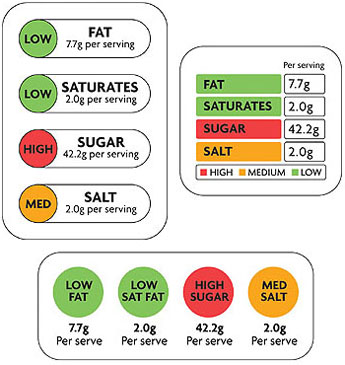Understanding Food Labels
Food labels can be confusing and difficult to understand. However, once you understand what to look at on a food label, it can be invaluable in helping you to make healthier food choices. By looking at labels you will become more aware of what you are putting into your body and it will make you realise just how small changes can make a big difference. The Government has implemented a form of food labelling called the traffic light system. This is to help make it quick and easy to make the healthier choice.

As you can see to the left, there are different forms that the traffic light system will be presented, however all have the same key components. The key nutrients colour coded are fat, saturated fat, sugar and salt. Red: indicates a high amount of the nutrient, hence representing an unhealthy amount. Amber: indicates the food isn’t high or low in the nutrient. Green: indicates the food contains a low amount of the nutrient and hence a healthier food. Try to choose foods with more green on the label for the healthier choice. The main foods that have traffic light labelling are processed convenience foods such as ready meals, pizzas, sausages, burgers, pies, sandwiches and breakfast cereals. Not all supermarkets have adopted the traffic light system; check the following website for a list: www.eatwell.gov.uk/foodlabels/trafficlights The other important part of the label to understand is the nutrition panel. You will see nutritional information per 100g/100ml and often also for a typical serving size. The main nutrients that have to be listed are energy (kcal and kj), fat (g), protein (g) and carbohydrate (g).other components commonly labelled will be the breakdown of the different fats (saturated, monounsaturated and polyunsaturated), salt/sodium and fibre. Salt is sodium chloride and if the label states the amount of sodium, it can be converted to salt: Salt (g) = sodium x 2.5. Carbohydrate will often be broken down to tell you how much of it is in the form of sugar.